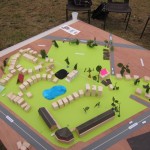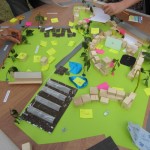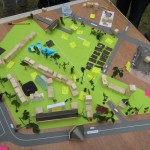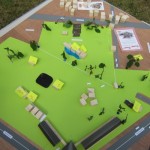Cohousing advantages - a personal reflection
Guest blog by Ali Phelps, a long-standing member of ChaCo
I’m not sure whether an inner city environment causes poor mental health or whether people experiencing it are there because of cheaper, rented or social housing, but I do know for certain that many of our neighbours, over my 42 years in Chapeltown, have been affected by a wide variety of social and psychiatric stresses. Cohousing is brilliant from this perspective. Although it isn’t planned from a medical point of view, lots about it can prevent or alleviate mental distress.
Isolation
In cohousing, individuals agree to meet each other intentionally through some shared meals, work groups and joint decision-making as well as expecting many accidental encounters because of the architecture and landscaping of the project. So if anyone’s pattern of behavior changes, or they become withdrawn, it will be noticed. People vary greatly in their need for privacy and interaction and cohousing is flexible enough to meet a wide range of expectations. Casual greetings, practical task-focused exchanges or philosophical conversations can all be a natural part of cohousing, and will enrich community life. For any members with distant or alienated families, the cohousing group may be the natural place for sharing joys and sorrows, and for support through times of illness and other stresses. The group can be helpful in reducing the likelihood of over-dependent relationships.
Life rhythms
Some residents will not be in full-time paid employment. Cultivating shared allotments, using the workshops, interacting with schools, training groups, the elderly, sporting and creative community groups as well as taking responsibility for shared meals, maintenance, cleaning and recycling will all provide ‘work’ type opportunities for purposeful daily activity. Prospective residents already have a wide range of skills to share – musical, creative, artistic and dexterous, which may contribute to the relaxation of the whole group. The space we design will lend itself to possible community celebrations of Bonfire Night, New Year(s), harvest and the Big Lunch as well as the variety of faith groups represented being able to share particular festivals, as appropriate. The rhythms of planting, tending, reaping and using food are always life-affirming and health-promoting.
Generations
Although some cohousing schemes opt for the familiarity of peer groups, there are overwhelming benefits to living in a deliberately multi-aged group. Children can know and trust a variety of adults from birth, thus building solid foundations for childcare and life-long emotional health. They will also naturally learn to relate to older and younger children. Elderly people can be rejuvenated by respectful interactions with youngsters, and can contribute wisdom, stories and practical skills even as they learn the mysteries of smartphones and websites. New parents can have support and practical help at stressful periods – easy babysitting options can contribute to saving strained partnerships, extra pairs of hands can offer needed hours of sleep for those insomniac moments. There can be mutual support through periods of illness or recovery without much effort from the group. Similarly, as individuals age, issues of mobility, memory, bereavement and strength may all be helped reasonably easily by a cohousing group, without incurring huge transport or financial costs.
Diversity
Those committed to the project have already valued diversity in education, race, language, faith, gender, abilities etc. and look forward to learning more through the closer living and decision-making of deliberate cohousing. It aims to celebrate Chapeltown as a district of immigration and welcome and to find ways of continuing to provide safe and affordable space for new arrivals as well as remaining open to settled neighbours near the cohousing project.
Sustainability
Cohousing makes it much easier to practice some aspects of green living, for example, shared transport, solar energy, recycling, bulk-buying, shared laundry facilities and cultivating. Construction from scratch should ensure sustainable materials, and high levels of insulation resulting in lower energy bills. Sharing of ideas and hope will contribute long-term benefits to the planet as well as improved health to the residents.
Some financial implications
Cohousing will result in lower living costs for residents.
- Energy: through sustainable building and shared facilities and activities.
- Food: through growing our own, bulk-buying and shared meals.
- Childcare: some will be natural, in-house.
- Things in common: because of the shared facilities, individual households will need less space and fewer tools, cars, equipment.
Statutory savings
- NHS: Fewer GP visits because of less isolation, fresh food, fresh air and exercise. Fewer psychiatric in-patient costs, as good patterns of living result in better mental health.
- Police: Fewer interventions. The cohousing group is very aware of the lack of out-of-school provision for young people in Chapeltown and would encourage relevant activities and inclusion. The cohousing group is committed to share problem-solving and is therefore less likely to have neighbourhood disputes needing police attention.
- Social Services:
If parents need hospital care, the group may have the capacity to look after children, preventing the disruption and expense of fostering/respite care.
Elderly people should be able to stay in their own homes for longer, with good informal neighbourhood support. Where professional carers are needed, residents would be able to provide additional company, mobility, and the stimulation essential for good quality of life.
Disabled people can be included more easily when building new, with raised beds in the growing space, design of communal space and wheelchair access. - Affordable space for groups to meet in the Common House e.g. A grandparents group, craft groups
- Education: If toilets and teaching spaces are available, the Leopold Field area could become much more usable both by the CHESS cluster and local residents. Sports spaces, a growing area, orchard, and pond could all contribute to a better quality of local education.
- Housing Support workers/CAB/Refugee Support workers:
Some issues could be solved in a shared community.
Not a World Cup event - but much more important
It’s approaching midnight on a momentous day. Brazil beat Cameroon 4 -1, England are slipping towards defeat in the latest cricket test match, Andy Murray has started strongly at Wimbledon and our garden is loaded (was loaded!) with strawberries.
But the event of the day was the completion of our pre-feasibility study. I’m not going to put all of it up here as it’s a massive 99 pages long. I’ll wait until we have an executive summary but in the meantime here’s a couple of highlights.
As part of the study we undertook 67 conversations using our questionnaire and discovered that
- people do know what makes a good community
- people want safe green space and growing space
- people want community facilities owned and managed by the community, which are not culturally specific to one ethnic group or religion
- there was a high level of concern about provision for teenagers and young adults
- people saw a need for affordable, well designed, good quality housing
Through these and many other conversations we have concluded that:
The Leopold site offers potential for innovative development, focused on building on the best traditions of Chapeltown and meeting the yearning people have for improved facilities and stronger community. It can deliver a mixed range of attractive new, affordable, low energy sustainable housing which can include self-build, co-housing and can meet a wide range of needs.
There is a real opportunity here to develop the site in ways which can enhance the community, improve resources and meet local aspirations, and can significantly contribute to improving community wellbeing. In particular it can offer a community based approach to growing and sharing food and providing improved sports facilities and access to nature for our children, and people of all ages. It can provide employment and training opportunities for local people. It can deliver community facilities which return ownership and responsibility to the people who live here.
So today has been momentous because our pre-feasibility study is complete and it means we are one step closer to achieving our vision to:
Transform derelict land; an under-used playing field, a dilapidated day-centre and run down historic buildings into a vibrant urban village bursting with sustainable housing, recreational space, opportunities for inter-generational connections and a diverse intentional community grown from the local
Goodnight.
Climb the fence and plant seeds
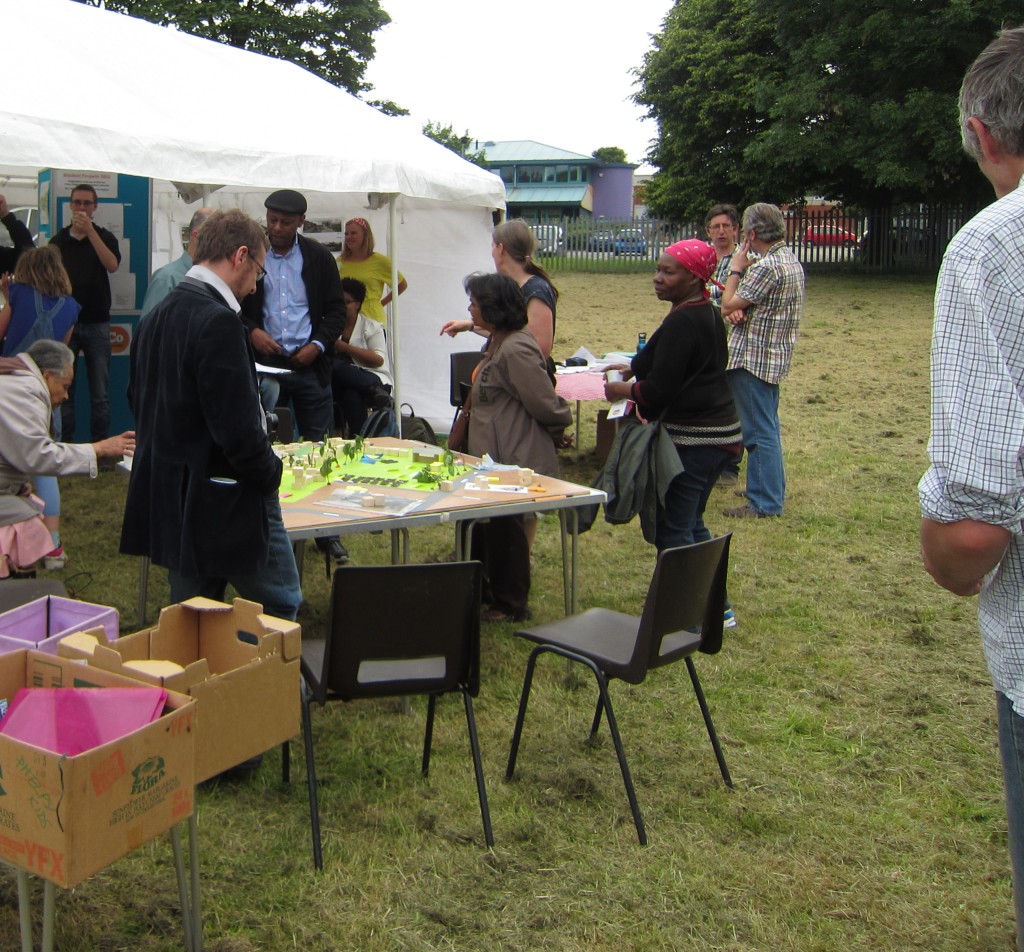 I’m so glad someone else picked the date for the Design Picnic. Last time I picked a date for an outdoor event we had thunder and lightning – just what you’d expect for mid-summer’s day!
I’m so glad someone else picked the date for the Design Picnic. Last time I picked a date for an outdoor event we had thunder and lightning – just what you’d expect for mid-summer’s day!
Around 100 people came to our design picnic. Most had never stepped onto the Leopold Field before – despite it being a community facility. One boy admitted he had played football on the site but this was only because he had climbed over the 6-foot high spiky fence that surrounds the site.
I was surprised by how many people said they’d like to see allotments and food growing projects as part of the development. Honestly, I didn’t prompt or lead them into it.
The whole event was much more relaxed than anticipated. The kids didn’t need any of our pre-prepared activities but simply created their own entertainment using the piles of cut grass. The adults (who weren’t jumping into piles of cut grass) were content to chat in twos or threes without any need for us to do presentations. The hands-on design model evolved throughout the afternoon with each person adding to what had gone before rather than re-inventing everything from scratch.
(Click on any photo to view the slideshow)
I’m most excited about the swimming pool with slides!
Chapeltown: where is it and what does it do?
Today four of us from Chaco listened to Max Farrar talk about Chapeltown.
I live in Chapeltown but if you search on Streetmap, which uses the official Ordnance Survey maps, you’ll find Chapeltown hanging out way up to the north of my house in Spencer Place. Google maps does much better by locating Chapeltown in Reginald Mount.
This geographical confusion explains some of the title of Max Farrar‘s talk as part of the Leeds Big Bookend festival.
The other half of the title was even more interesting. Max is a Professor with Leeds Metropolitan University who spent 25 years studying Chapeltown (and for most of the time living here as well). Max summed up his talk by saying
Chapeltown provides a repository for the racialised hopes and fears of a divided city; a site on which various social imaginaries do their work.
I’m not sure I understand the summary! What I did understand is that there are many stories told about Chapeltown. These stories present only one way of looking at it, miss the incredible diversity in the area, and often misrepresent the area.
The story I want to tell is much better summed up by the sub-heading of Max’s 400 page book: The Struggle for “Community” in a British Multi-Ethnic Inner City Area – Paradise in the Making.
I believe that Chaco can be a part of making paradise here.
Half price houses
Interesting article (once you get past the man in the hard-hat).
Basically a Community Land Trust (CLT) is developing houses that really are affordable. The article doesn’t say enough about how they have managed this. My guess is that the land has been given to the CLT at no or very little cost. CLTs ensure that land is permanently for the benefit of the community and as such are excellent ways of using public land rather than simply selling it to a developer out to make a profit.
House warming
I don’t think I’m as sociable as some of the other cohousers. I remember seeing the Lilac cohousing social calendar and thinking there’s no way I could do all that. It’s taken us over two months to organise a simple house warming party.
I guess partly that’s because other cohousing stuff has been keeping us busy. One of our Chaco members was recently chatting to a Lancaster Cohousing member. They stressed that building the community is as critical as building the houses. I think we’re doing all right on that but it’s a small tightly knit group that at some point will have to expand.
The house warming was part of the expansion – a chance for people interested in Chaco to get to know us a little better and see how we’re approaching housing in our current situation. The internally insulated wall in the kitchen looks insignificant but in some ways demonstrates what we are hoping for:
- environmentally friendly
- learning – it was achieved by asking an expert to teach us – so we could learn to replicate the approach elsewhere
- beautiful – as much as a wall can be! The only unusual feature is the 45 degree angle into the window – this looks good, lets in more light and meant extra time and effort to make it to work.
- planned with the future in mind. Only one wall was done – but it needed to be done before the kitchen was installed. We also did it in such a way that any future insulation can neatly link into the work we’ve already done.
Getting the best from solicitors
I was surprised today. We went to meet Wrigley’s solicitors to pick their brains about legal structures that might be useful in realising our vision for the whole of the site and for our cohousing bit. We were met by a team of four, including one of the partners, who gave us over an hour of their time for free.
Much of what they were saying echoed our previous conversation with Cornerstone Cath. There seemed to be a clear message that a Community Land Trust could work well for the whole site.
It does leave us with a significant question – how much can we actually lead on the bigger site? We know from talking to people involved in other cohousing developments that even doing just 20-30 houses is extremely demanding. How much more demanding will it be to set up and lead a Community Land Trust to develop the whole site?
It may be easier to concentrate on our own little bit and ignore the rest. It may be easier but I’m not sure it’s best. Tackling the site as a whole brings huge benefits. It means the site can respond to the needs of the surrounding community, it gives an opportunity to open up and connect more clearly with existing Chapeltown communities, and working on the larger scale gives advantages in terms of environmental options, building the infrastructure – roads, drains and other services.
If we’re thinking big then we’re going to need support. We’ll need good community support and plenty of involvement (or leadership) from partners.
Hard decisions
We have two kinds of meeting – one is a meeting with a little bit of eating, the other is eating with a little bit of meeting! I guess you can tell which meeting it is by how much cutlery and how many plates are on the table. Tonight was a full dinner!
But we also followed it with a full agenda of meeting. We were using some questions to help us clarify our thinking on some tricky issues. Here’s a crucial one:
How important is it that people can get on the housing ladder through cohousing? Very important or Not important?
I think my own mind changed several times during the evening. I live in a housing cooperative out of choice because I don’t really like the housing ladder and think it is more of a housing treadmill than a ladder. I’m not convinced that rising house prices are good for anyone apart from the rich, who can profit from owning more than one house.
So perhaps I should be happy with the Lilac cohousing model, where house prices are linked to average earnings rather than market value.
The problem is that while eating we were also meeting new people interested in cohousing. It started me thinking about young people with children, living in rented accommodation and wanting to buy – wanting security of housing, wanting to build a future where they pay off a mortgage and have no rent, wanting to leave something for their children.
Cohousing (and housing cooperatives) are actually almost certainly more secure than other housing models – much more secure than buying through a mortgage. They can also be more affordable.
Where they differ is in how they deal with buying and benefiting from house price rises. It seems that cohousing schemes are often so popular that they increase housing prices – not only on their own site, but also in the surrounding area. This can lead to a situation where only the wealthy can join.
So perhaps we shouldn’t have a buy and sell option in our cohousing. But if that were the case then what about the young family – would they want to join? I’m not sure they would.
In Chaco we’ve placed a high importance on openness, diversity, accessibility and community. In other words, we want it to be easy for an array of ordinary people to be able to join. This might mean that challenging or changing the economics of housing drops down our list and may not be a priority at all.
That one simple question provided plenty to think about. Other questions and answers were much easier. Yes – we only want people joining who are committed to the community aspects of cohousing. No – people just wanting cheap housing are not welcome.
The benefit of cooperation
We had a very useful meeting with Cath from Cornerstone Cooperative and Radical Routes. Cath is well know as an expert on housing cooperatives and more widely on radical approaches to housing.
We’d gone to ask for help with thinking about legal structures and how to organise ourselves. What we got were some very clear questions that needed answers. Deciding on legal structures seemed like a difficult task, but Cath helped us see that in fact the structures are pretty simple – but only once you are clear about your values.
We still have quite a bit of work to do on this. The problem is that sometimes some of our values are in tension with others.
So we came away without any clear resolutions but some very clear unresolved questions that I’ll try get the Chaco group answering next time we meet.
YES!
We had a significant meeting with the council today. We met senior council officers and a councillor to talk about our aspirations for cohousing and how this could work on the site we have in mind.
The most exciting outcome was realising that the council were saying YES – let’s see if we can get cohousing to work here. Okay, I couldn’t jump up and down and celebrate too much, as there’s nothing in writing and no legal agreement. I know that many things could stop our dreams from happening. I realise that we will have to prove that we can deliver and that cohousing is feasible.
But… the more I think about it the more exciting it is. They actually said yes. They actually want to see if we can make it happen.



